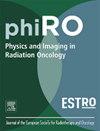Development and external multicentric validation of a deep learning-based clinical target volume segmentation model for whole-breast radiotherapy
IF 3.3
Q2 ONCOLOGY
引用次数: 0
Abstract
Background and purpose:
In order to optimize the radiotherapy treatment and minimize toxicities, organs-at-risk (OARs) and clinical target volume (CTV) must be segmented. Deep Learning (DL) techniques show significant potential for performing this task effectively. The availability of a large single-institute data sample, combined with additional numerous multi-centric data, makes it possible to develop and validate a reliable CTV segmentation model.
Materials and methods:
Planning CT data of 1822 patients were available (861 from a single center for training and 961 from 8 centers for validation). A preprocessing step, aimed at standardizing all the images, followed by a 3D-Unet capable of segmenting both right and left CTVs was implemented. The metrics used to evaluate the performance were the Dice similarity coefficient (DSC), the Hausdorff distance (HD), and its 95th percentile variant (HD_95) and the Average Surface Distance (ASD).
Results:
The segmentation model achieved high performance on the validation set (DSC: 0.90; HD: 20.5 mm; HD_95: 10.0 mm; ASD: 2.1 mm; epoch 298). Furthermore, the model predicted smoother contours than the clinical ones along the cranial–caudal axis in both directions. When applied to internal and external data the same metrics demonstrated an overall agreement and model transferability for all but one (Inst 9) center.
Conclusion:
. A 3D-Unet for CTV segmentation trained on a large single institute cohort consisting of planning CTs and manual segmentations was built and externally validated, reaching high performance.
基于深度学习的全乳房放疗临床靶体积分割模型的开发与外部多中心验证
背景与目的:为了优化放疗治疗和减少毒性,必须对危险器官(OARs)和临床靶体积(CTV)进行分割。深度学习(DL)技术显示出有效执行此任务的巨大潜力。大型单一机构数据样本的可用性,加上额外的众多多中心数据,使得开发和验证可靠的CTV分割模型成为可能。材料与方法:收集1822例患者的计划CT资料(861例来自单个培训中心,961例来自8个验证中心)。一个预处理步骤,旨在标准化所有的图像,然后是一个3D-Unet能够分割左右ctv。用于评估性能的指标是Dice相似系数(DSC), Hausdorff距离(HD)及其第95百分位变体(HD_95)和平均表面距离(ASD)。结果:该分割模型在验证集上取得了较好的分割效果(DSC: 0.90;高清:20.5 mm;HD_95: 10.0 mm;ASD: 2.1 mm;时代298)。此外,该模型在两个方向上沿颅尾轴预测的轮廓比临床的轮廓更平滑。当应用于内部和外部数据时,相同的度量标准显示出除了一个(第9组)中心之外的所有中心的总体一致性和模型可移植性。建立了一个用于CTV分割的3D-Unet,该3D-Unet在由规划ct和手动分割组成的大型单一研究所队列中进行了训练,并进行了外部验证,达到了高性能。
本文章由计算机程序翻译,如有差异,请以英文原文为准。
求助全文
约1分钟内获得全文
求助全文
来源期刊

Physics and Imaging in Radiation Oncology
Physics and Astronomy-Radiation
CiteScore
5.30
自引率
18.90%
发文量
93
审稿时长
6 weeks
 求助内容:
求助内容: 应助结果提醒方式:
应助结果提醒方式:


